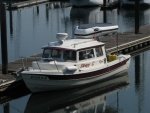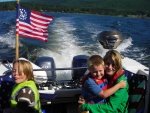Recently released by the Chicago Yacht club the findings of a committee review of crew overboard which occurred during the 2018 Chicago Yacht Club Race to Mackinac on July 21, 2018.
Read report here.
Conditions were what I would consider "Rough" but not unusual for a long sailboat race.
A quick summery: The owner of the 52 foot racing sailboat was not aboard, and was ill. There was a full compliment of 13 crew members all very experienced and a cumulative experience of 245 Chicago to Mackinac races. 95% of the crew had formal training in safety at sea--two members had expired certificates (over 5 years old)
A cursory dock talk, may not have fully addressed the COB situation, and there was a "Hat over board" drill accomplished in the harbor, under power, retrieved with a boat hook (?). This did not replicate the sailing conditions of that day.
The crew member was using an inflatable life jacket, belonging to the boat--and it supposedly had been inspected within two weeks. The boat was equipped with a life sling, MOM8 and a heaving line.
The COB occurred within 26 minutes of the start of the race, and was under 25 knots of wind and seas up to 8 feet. Boat speed 9,.5 knots at 50* off the wind. The COB was aft in the cockpit tending the jib winch and had moved to tighten the vang, the rest of the crew, except driver was on the windward rail. The COB. lost his footing with a wave hitting the boat, and hung onto the boat for at least a few seconds before he was noted to be mission. MOB was immediately marked on the GPS by both the TP52 and a nearby competitor within 20 seconds of the COB. A designated spotter began to keep eyes and point to the COB. COB life jacket never inflated despite hydrostatic inflator, manual to auto tab and air tube to inflate by mouth. On the TP 52 it takes most of the crew to get both the Main and jib down safely, and the first attempt was made under sail. By this time the jib was fouled and could not be fully lowered. Engine was started and active for second attempt; during the 3rd attempt a wave caught the COB and swept him under the boat--he sank shortly there after, and body recovered days later. DSC was not triggered for 15 minutes and several attempts at rescue. CG and other rescue agencies did not respond on scene for 45 minutes.
The major lessons were: Always have a specific life jacket that the crew member is familiar with. Have a designated spotter. Get materials in the water (MOM8 in this case: This is an auto inflatable collar to go under armpits, an inflatable pylon with strobe light, a drogue--all of which deploy immediately over the stern on activation.). Could also be a floatation cushion, life ring or fender. A life sling was never deployed. The throw rope was never deployed.
My takeaway was that sail should have been dropped immediately. The COB may not have been familiar with life jacket. Unknown is why the Life Sling, MOM8 or throwing line were not deployed. MOM8 immediately--the life sling on the first pass and an attempt to throw the heaving line (instead of trying to throw the sheets of the boat's jib). Most of the professional ocean racers have designated and trained rescue swimmer to be used in rough conditions. Perhaps more recreational offshore racers should also designate rescue swimmers.
Moral, train for crew overboard. Check the life jackets and be familiar. Check and replace bobbins and cartridges yearly or at least every 2 years. Be familiar with DSC and employ immediately, be aware of MOB function of GPS. If falling overboard shed your boots, and other gear which give difficulty swimming
Our own preparations include a number of MOB drills in the past. We have a Life ring in the cockpit--and a heaving line nearby in a throw bag. We also have fenders always available to throw out of the cockpit. We nearly always have our crane davit rigged--capacity is 150#, but I am sure it would handle my 180# weight to recover me if necessary.
Read report here.
Conditions were what I would consider "Rough" but not unusual for a long sailboat race.
A quick summery: The owner of the 52 foot racing sailboat was not aboard, and was ill. There was a full compliment of 13 crew members all very experienced and a cumulative experience of 245 Chicago to Mackinac races. 95% of the crew had formal training in safety at sea--two members had expired certificates (over 5 years old)
A cursory dock talk, may not have fully addressed the COB situation, and there was a "Hat over board" drill accomplished in the harbor, under power, retrieved with a boat hook (?). This did not replicate the sailing conditions of that day.
The crew member was using an inflatable life jacket, belonging to the boat--and it supposedly had been inspected within two weeks. The boat was equipped with a life sling, MOM8 and a heaving line.
The COB occurred within 26 minutes of the start of the race, and was under 25 knots of wind and seas up to 8 feet. Boat speed 9,.5 knots at 50* off the wind. The COB was aft in the cockpit tending the jib winch and had moved to tighten the vang, the rest of the crew, except driver was on the windward rail. The COB. lost his footing with a wave hitting the boat, and hung onto the boat for at least a few seconds before he was noted to be mission. MOB was immediately marked on the GPS by both the TP52 and a nearby competitor within 20 seconds of the COB. A designated spotter began to keep eyes and point to the COB. COB life jacket never inflated despite hydrostatic inflator, manual to auto tab and air tube to inflate by mouth. On the TP 52 it takes most of the crew to get both the Main and jib down safely, and the first attempt was made under sail. By this time the jib was fouled and could not be fully lowered. Engine was started and active for second attempt; during the 3rd attempt a wave caught the COB and swept him under the boat--he sank shortly there after, and body recovered days later. DSC was not triggered for 15 minutes and several attempts at rescue. CG and other rescue agencies did not respond on scene for 45 minutes.
The major lessons were: Always have a specific life jacket that the crew member is familiar with. Have a designated spotter. Get materials in the water (MOM8 in this case: This is an auto inflatable collar to go under armpits, an inflatable pylon with strobe light, a drogue--all of which deploy immediately over the stern on activation.). Could also be a floatation cushion, life ring or fender. A life sling was never deployed. The throw rope was never deployed.
My takeaway was that sail should have been dropped immediately. The COB may not have been familiar with life jacket. Unknown is why the Life Sling, MOM8 or throwing line were not deployed. MOM8 immediately--the life sling on the first pass and an attempt to throw the heaving line (instead of trying to throw the sheets of the boat's jib). Most of the professional ocean racers have designated and trained rescue swimmer to be used in rough conditions. Perhaps more recreational offshore racers should also designate rescue swimmers.
Moral, train for crew overboard. Check the life jackets and be familiar. Check and replace bobbins and cartridges yearly or at least every 2 years. Be familiar with DSC and employ immediately, be aware of MOB function of GPS. If falling overboard shed your boots, and other gear which give difficulty swimming
Our own preparations include a number of MOB drills in the past. We have a Life ring in the cockpit--and a heaving line nearby in a throw bag. We also have fenders always available to throw out of the cockpit. We nearly always have our crane davit rigged--capacity is 150#, but I am sure it would handle my 180# weight to recover me if necessary.


